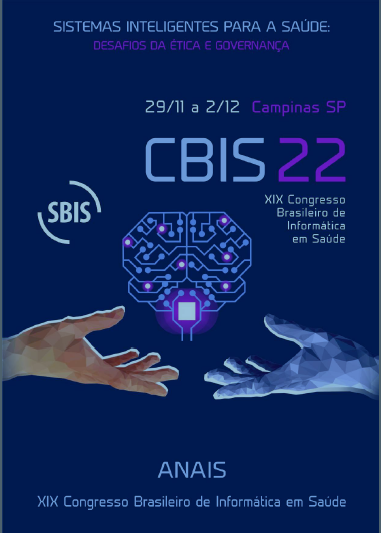Comparative Analysis of the Size of the Local Binary Pattern for Segmentation of Pulmonary Fissure
DOI:
https://doi.org/10.59681/2175-4411.v15.iEspecial.2023.1109Keywords:
Lung Fissure, LBP texture, Artificial Neural NetworkAbstract
In order to obtain a more effective lung fissure segmentation, the present work has the objective of performing fissure segmentation using LBP texture measures and Artificial Neural Networks. For the implementation of the algorithm an MLP (Multilayer Perceptron) was used. To perform the algorithm validations a gold standard was created by extracting a total of 100 images from 5 exams from the LOLA11 database. For the set of images tested, the classifier performed best when the window size, 15x15 pixels, was used to generate the LBP histogram. The low incidence of false negative detections, along with the reduction of false positive detections, results in a high hit rate. It is concluded that the lung fissure segmentation technique is a useful algorithm for segmenting lung fissures in CT images, and with the potential to integrate systems to aid medical diagnosis.
Downloads
References
Guo Z, Zhang L, Zhang D. A completed modeling of local binary pattern operator for texture classification. IEEE transactions on image processing. 2010 Mar 8;19(6):1657-63.
Haykin S. Neural networks and learning machines, 3/E. Pearson Education India; 2009 Nov.
Kuhnigk JM. Quantitative analysis of lung morphology and function in computed tomographic images (Doctoral dissertation, Universität Bremen).
Lassen B, van Rikxoort EM, Schmidt M, Kerkstra S, van Ginneken B, Kuhnigk JM. Automatic segmentation of the pulmonary lobes from chest CT scans based on fissures, vessels, and bronchi. IEEE transactions on medical imaging. 2012 Sep 20;32(2):210-22.
Li B, Christensen GE, Hoffman EA, McLennan G, Reinhardt JM. Establishing a normative atlas of the human lung: intersubject warping and registration of volumetric CT images. Academic radiology. 2003 Mar 1;10(3):255-65.
Murata N, Yoshizawa S, Amari SI. Network information criterion-determining the number of hidden units for an artificial neural network model. IEEE transactions on neural networks. 1994 Nov;5(6):865-72.
Ojala T, Pietikainen M, Maenpaa T. Multiresolution gray-scale and rotation invariant texture classification with local binary patterns. IEEE Transactions on pattern analysis and machine intelligence. 2002 Aug 7;24(7):971-87.
Pu J, Leader JK, Zheng B, Knollmann F, Fuhrman C, Sciurba FC, Gur D. A computational geometry approach to automated pulmonary fissure segmentation in CT examinations. IEEE transactions on medical imaging. 2008 Dec 9;28(5):710-9.
Ritter F, Boskamp T, Homeyer A, Laue H, Schwier M, Link F, Peitgen HO. Medical image analysis. IEEE pulse. 2011 Dec 1;2(6):60-70.
Suter BW. The multilayer perceptron as an approximation to a Bayes optimal discriminant function. IEEE transactions on neural networks. 1990 Dec;1(4):291.
Sato Y, Westin CF, Bhalerao A, Nakajima S, Shiraga N, Tamura S, Kikinis R. Tissue classification based on 3D local intensity structures for volume rendering. IEEE Transactions on visualization and computer graphics. 2000 Apr;6(2):160-80.
van Rikxoort EM, van Ginneken B, Klik M, Prokop M. Supervised enhancement filters: Application to fissure detection in chest CT scans. IEEE transactions on medical imaging. 2007 Dec 26;27(1):1-0.
Wang J, Betke M, Ko JP. Pulmonary fissure segmentation on CT. Medical Image Analysis. 2006 Aug 1;10(4):530-47.
Wiemker R, Bülow T, Blaffert T. Unsupervised extraction of the pulmonary interlobar fissures from high resolution thoracic CT data. InInternational Congress Series 2005 May 1 (Vol. 1281, pp. 1121-1126). Elsevier.
Downloads
Published
How to Cite
Issue
Section
License
Copyright (c) 2023 Edson Cavalcanti Neto, Darlan Almeida Barroso, Tarique Cavalcante, Thomaz Maia de Almeida, Alyson Bezerra Ribeiro, Paulo Cézar Cortez, André Cristiano de Souza, Jessyca Almeida Bessa

This work is licensed under a Creative Commons Attribution-NonCommercial-ShareAlike 4.0 International License.
Submission of a paper to Journal of Health Informatics is understood to imply that it is not being considered for publication elsewhere and that the author(s) permission to publish his/her (their) article(s) in this Journal implies the exclusive authorization of the publishers to deal with all issues concerning the copyright therein. Upon the submission of an article, authors will be asked to sign a Copyright Notice. Acceptance of the agreement will ensure the widest possible dissemination of information. An e-mail will be sent to the corresponding author confirming receipt of the manuscript and acceptance of the agreement.





